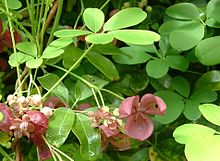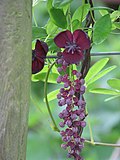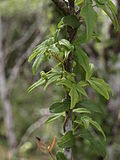Lardizabalaceae
This article may be expanded with text translated from the corresponding article in Spanish. (December 2009) Click [show] for important translation instructions.
|
| Lardizabalaceae | |
|---|---|

| |
| Akebia quinata | |
| Scientific classification | |
| Kingdom: | Plantae |
| Clade: | Tracheophytes |
| Clade: | Angiosperms |
| Clade: | Eudicots |
| Order: | Ranunculales |
| Family: | Lardizabalaceae R.Br.[1] |
| Genera | |
|
See text | |
| Synonyms | |
| |
Lardizabalaceae is a family of flowering plants.
The family has been universally recognized by taxonomists, including the APG II system (2003; unchanged from the APG system of 1998), which places it in the order Ranunculales, in the clade eudicots.
The family consist of 7 genera with about 40 known species[2][3] of woody plants. All are lianas, save Decaisnea, which are pachycaul shrubs. The leaves are alternate, and compound (usually palmate), with pulvinate leaflets. The flowers are often in drooping racemes.
They are found in eastern Asia, from the Himalayas to Japan, with the exception of the genera Lardizabala and Boquila, both native to southern South America (Chile, and Boquila also in adjacent western Argentina).
Genera[]
| Image | Genus | Common name | Number of living species |
|---|---|---|---|
 |
Akebia Decne. | 4 | |
| C.Y.Wu, T.C.Chen & H.N.Qin' | 1 | ||
 |
Boquila Decne. | Chameleon vine | 1 |
 |
Decaisnea Hook.f. & Thomson' | Dead man's fingers | 1 |
 |
Holboellia | 5 | |
 |
Lardizabala Ruiz & Pav. | Zabala fruit | 1 |
 |
Sargentodoxa Rehder & E.H.Wilson | 1 | |
 |
Sinofranchetia Hemsl. | 1 | |
 |
Stauntonia DC. | 16 |
References[]
- ^ Angiosperm Phylogeny Group (2009). "An update of the Angiosperm Phylogeny Group classification for the orders and families of flowering plants: APG III" (PDF). Botanical Journal of the Linnean Society. 161 (2): 105–121. doi:10.1111/j.1095-8339.2009.00996.x. Retrieved 2013-07-06.
- ^ Christenhusz, M. J. M. (2012). "An overview of Lardizabalaceae". Curtis's Botanical Magazine. 29 (3): 235–276. doi:10.1111/j.1467-8748.2012.01790.x.
- ^ Christenhusz, M. J. M.; Byng, J. W. (2016). "The number of known plants species in the world and its annual increase". Phytotaxa. 261 (3): 201–217. doi:10.11646/phytotaxa.261.3.1.
External links[]
 Media related to Lardizabalaceae at Wikimedia Commons
Media related to Lardizabalaceae at Wikimedia Commons- Lardizabalaceae in the Flora of North America
- Lardizabalaceae in the Flora of China
- links at CSDL
- Chilean Lardizabalaceae at Chileflora
Categories:
- Lardizabalaceae
- Eudicot families